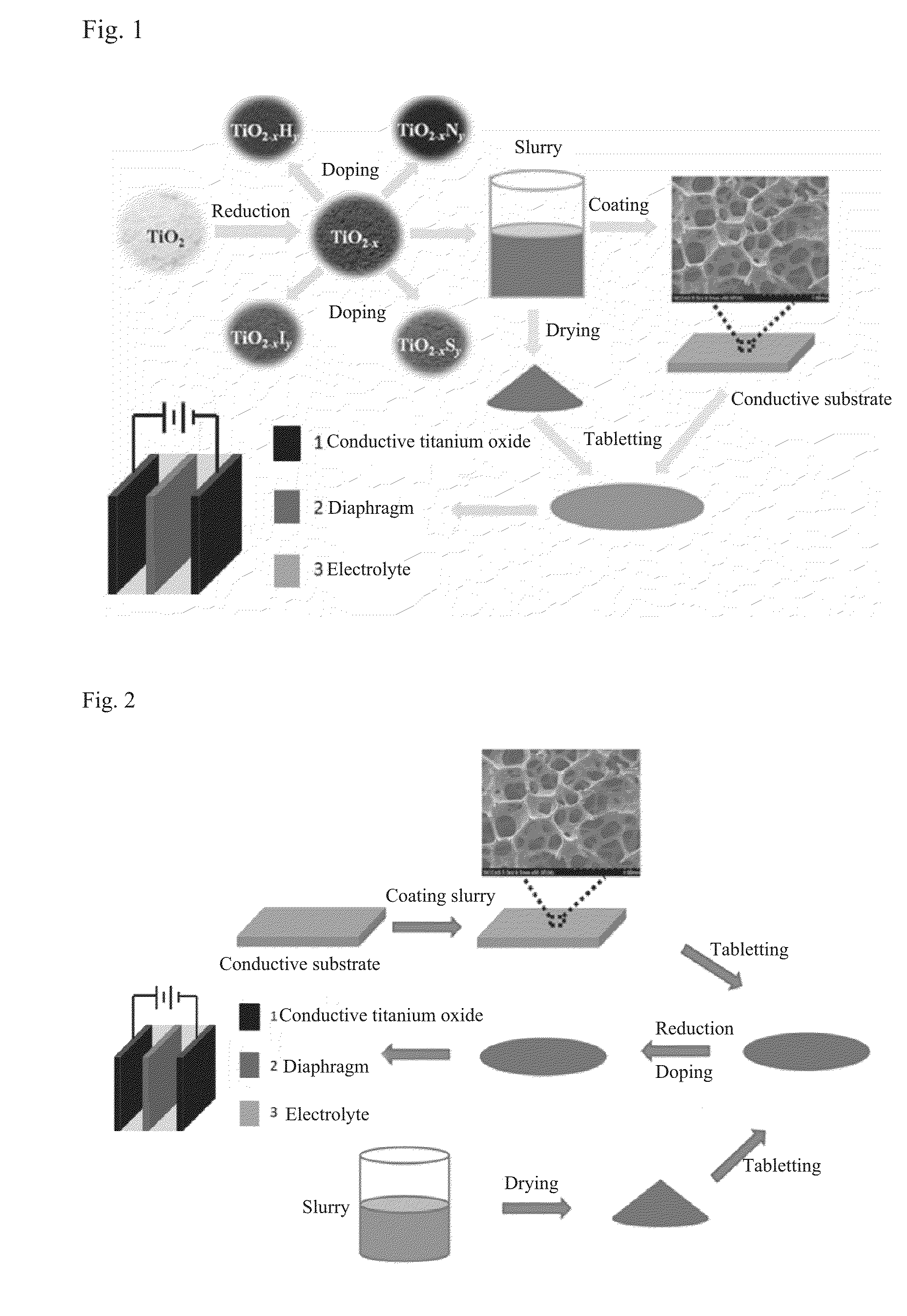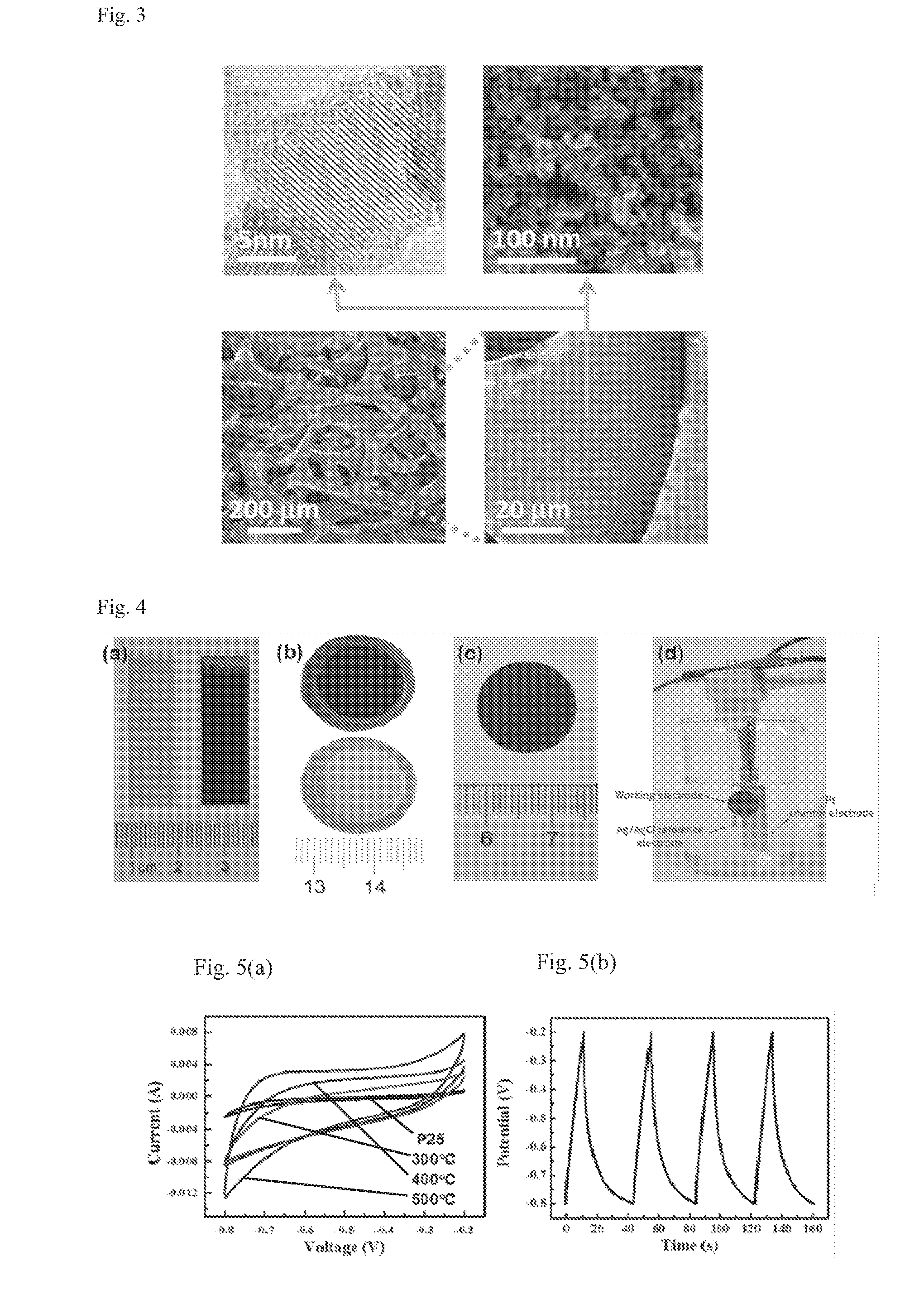Titanium oxide-based supercapacitor electrode material and method of manufacturing same
a supercapacitor electrode and titanium dioxide technology, which is applied in the manufacture of hybrid capacitor electrodes, hybrid/edl capacitor electrodes, and titanium suboxides, etc., can solve the problems of reducing the service life of batteries, secondary chemical batteries are unable to meet such needs, and reducing the service life of such batteries, so as to improve the conductivity of the resulting titanium dioxide, the effect of low equipment requirements and low cos
- Summary
- Abstract
- Description
- Claims
- Application Information
AI Technical Summary
Benefits of technology
Problems solved by technology
Method used
Image
Examples
example 1
[0100]A commercial titanium oxide powder (P25) as the raw material, and an aluminum metal as the highly active reducing metal are placed in different heating sections in a sealed tube furnace, respectively, and the whole system is vacuumized to 0.1 Pa. Then the aluminum and the titanium oxide are heated to 800° C. and 300˜500° C., respectively. After a reaction of 8 hours, the heating power is turned off, and the sample cools down. To 3 mL solution of polyvinylidene fluoride in N-methyl-2-pyrrolidone (20 mg / mL) is added 0.4 g of the reduced P25 powder. The mixture is stirred for 8 h to give a uniformly dispersed titanium dioxide slurry. The titanium dioxide slurry is uniformly coated on a nickel net by knife coating, then dried under vacuum at 100° C. for 8 h.
[0101]The picture of the reduced titanium dioxide (TiO2-x) powder is shown in FIG. 1, and it can be seen therefrom that the powder turns black after reduction.
[0102]The density of charge carrier of the reduced titanium dioxide ...
example 2
[0106]An amorphous titanium dioxide made by hydrolysis of titanium tetrachloride as the raw material, and an aluminum metal as the highly active reducing metal are uniformly mixed together and placed in a sealed tube furnace, and the whole system is vacuumized to 0.1 Pa. Then the sample is heated to 300˜500° C. After a reaction for 8 hours, the heating power is turned off, and the sample cools down. Then, an ammonia gas is filled into the sealed system, and the titanium dioxide is heated to 600° C. to undergo a nitriding treatment for 4 h. The sample is taken out after cooling down. To 3 mL solution of polyvinylidene fluoride in N-methyl-2-pyrrolidone (20 mg / mL) is added 0.4 g of the reduced black powder. The mixture is stirred for 8 h to give a uniformly dispersed titanium dioxide slurry. The titanium dioxide slurry is uniformly coated on a nickel net by knife coating, then dried under vacuum at 100° C. for 8 h.
[0107]As shown in “TiO2—N” of FIG. 1, the amorphous titanium dioxide po...
example 3
[0110]An amorphous titanium dioxide made by hydrolysis of titanium tetrachloride (same as that in Example 2) as the raw material, and an aluminum metal as the highly active reducing metal are uniformly mixed together and placed in a sealed tube furnace, and the whole system is vacuumized to 0.1 Pa. Then the sample is heated to 500° C. After a reaction for 8 hours, the heating power is turned off, and the sample cools down. Then, a hydrogen sulfide gas is filled into the sealed system, and the titanium dioxide is heated to 600° C. to undergo a sulfuration treatment for 4 h. The sample is taken out after cooling down. To 1.5 mL solution of polyvinylidene fluoride in N-methyl-2-pyrrolidone (20 mg / mL) is added 0.4 g of the reduced and sulfurized amorphous powder. The mixture is stirred for 8 h to give a uniformly dispersed titanium dioxide slurry. The titanium dioxide slurry is uniformly coated on a nickel net by knife coating, then dried under vacuum at 100° C. for 8 h.
[0111]As shown i...
PUM
| Property | Measurement | Unit |
|---|---|---|
| thickness | aaaaa | aaaaa |
| concentration | aaaaa | aaaaa |
| concentration | aaaaa | aaaaa |
Abstract
Description
Claims
Application Information
 Login to View More
Login to View More - R&D
- Intellectual Property
- Life Sciences
- Materials
- Tech Scout
- Unparalleled Data Quality
- Higher Quality Content
- 60% Fewer Hallucinations
Browse by: Latest US Patents, China's latest patents, Technical Efficacy Thesaurus, Application Domain, Technology Topic, Popular Technical Reports.
© 2025 PatSnap. All rights reserved.Legal|Privacy policy|Modern Slavery Act Transparency Statement|Sitemap|About US| Contact US: help@patsnap.com



